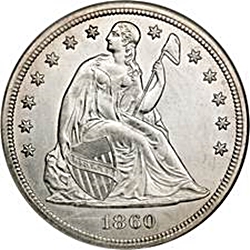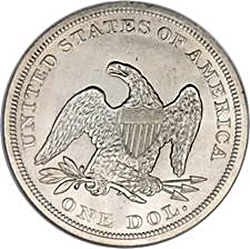 |
1860
 

|
 |
General Comments
1860 is like 1859 in that it would appear to be a common date based on its mintage, ranking of 39th out of 47.
We rate the date as very scarce. In business strike format 1860 is one of the most underrated dates in the series.
Most of the coins minted were exported to the Orient and subsequently melted for their silver content.
Examples can be located, but patient searching is required. They are scarce in all grades, but more available
than 1859 in high grades. They only become rare in gem BU. With price guides valuing it as a common date,
1860 defines the term “underrated”.
|
| |||||||||||||||||||||
1860 examples are usually well struck, occasionally displaying very slight softness on the star centrals and hair detail. Reverses are usually sharp. High-grade business strikes are often prooflike or semi-prooflike. With high mintage and a small number of die pairings we would expect that the dies wore sufficiently to eliminate prooflike surfaces for most examples, but this doesn’t seem to be the case. Apparently, the coins that stayed in the United States came from the early part of the mintage. We’ve noted numerous proofs that display slight strike weakness, particularly on a few of the stars and the upper edge of the eagle’s left wing. Since one proof die pair was later used to create business strikes it’s possible that these weakly struck proofs are actually early business strikes. We’ve found no conclusive way to separate those coins intended to be proofs from those intended for circulation.
1860 Die Marriages
Click the links below to view the details of each die marriage.
Die Marriage |
Rarity |
Obverse Die |
Reverse Die |
Estimated Survivors |
| OC-1 | R3+ | 1 | A | 260 |
| OC-2 | R4 | 2 | B | 140 |
| OC-3 | R4+ | 2 | C | 105 |
| OC-4 | R4+ | 3 | C | 105 |
| OC-5 | R5 | 3 | D | 60 |
| OC-5a | R7 | 3 | D | 5 |
| OC-6 | R4- | P1 | PA | 200 |
| OC-7 | R6- | 2 | A | 25 |
| OC-P1 | R2 | P1 | PA | 525 |
| OC-P2 | Currently unknown | P1 | 1856 PA | Currently unknown |
1860 Business Strike Emission Sequence
Since our book was first published, we’ve acquired a high-grade example of OC-7, as well as doing additional
research on die states from the pictures in the Heritage archives. The result has been a significant re-work
of the 1860 business strike emission sequence.
There is enough overlap among the 6 of the 7 business strike die marriages to identify the emission sequence,
although some uncertainty still exists. We know from obverse die clashing that OC-5 came before OC-4. It
could be anywhere in the sequence from the first position to the fifth. To place it we assumed that OC-5,
OC-4, and OC-5a were minted in sequence without removing Obverse 3 from the coining press. The position of
OC-6 is arbitrary since the die pair is unique. However, we know that these coins were minted after all
proofs were issued, so we assumed that they fall at the end of the sequence.
Emission Order |
Die Marriage |
Comments |
| 1 | OC-1 | OC-1 is first or second in the sequence, depending on where we place OC-5 |
| 2 | OC-2 | Obverse 2 die wear places OC-2 before OC-7. |
| 3 | OC-7 | Obverse 2 die wear places OC-7 after OC-2.
Reverse A die wear places OC-7 after OC-1. |
| 4 | OC-3 | Obverse 2 die wear places OC-3 after OC-7
Reverse C die wear places OC-3 before OC-4. |
| 5 | OC-5 | One example noted with a perfect obverse die places OC-5 before OC-4. |
| 6 | OC-4 | Obverse 3 die clashing places OC-4 after OC-5.
Reverse C die wear places OC-4 after OC-3. |
| 7 | OC-5a | Obverse 3 die clashing places OC-5a after OC-4. |
| 8 | OC-6 | No dies are shared with other die marriages (except the proofs). We know that this die marriage was generated after all proofs were minted, therefore late in the year. We assumed that it was last in the sequence. |
1860 Proof Emission Sequence
With just a single proof die marriage confirmed the emission sequence is simple. It should be noted that Reverse PA
die wear indicates that these proofs were minted at several different times, and that they preceded the business
strikes from the same die pair.
Emission Order |
Die Marriage |
Comments |
| 1 | OC-P1 |
1860 Quick Finder Chart
Attributing 1860 die marriages can be difficult. Neither the obverse nor reverse dies display major markers.
Date positions are different enough to allow attribution, but the differences are minor, so care must be taken.
The following table lists the keys for identifying each variety.
Die Marriage |
Obv Die |
Rev Die |
Right |
Keys |
| OC-1 | 1 | A | JL of RE | Obverse: No notable markers. 1 is vertically centered. Reverse: No notable markers. The shield recesses are almost completely finished. |
| OC-2 | 2 | B | LE | Obverse: Date slants VS down. Die lines in denticles above stars 6-7. Die line in gown left of Y. Reverse: Die line in the the denticles above A3. In late states die lines join the lower serifs of E2 and S2. |
| OC-3 | 2 | C | LE | Obverse: Date slants VS down. Die lines in denticles above stars 6-7. Die line in gown left of Y. Reverse: A small die chip off the bottom of the middle arrow shaft, directly above the upper tip of the arrowhead. |
| OC-4 | 3 | C | B | Obverse: Date slants VS down. Reverse: A small die chip off the bottom of the middle arrow shaft, directly above the upper tip of the arrowhead. |
| OC-5 | 3 | D | B | Obverse: Date slants VS down. Heavy Unclashed or a single clash mark in the drapery near the pole base. Reverse: A light die line in the unfinished area between them joins leaves 1 and 2. |
| OC-5a | 3 | D | B | Obverse: Doubled clash marks in the drapery near the pole base. Reverse: A light die line in the unfinished area between them joins leaves 1 and 2. |
| OC-6 | P1 | PA | LE | Obverse: Both 1 and 0 are VSH. Reverse: Faint die lines in the shield recesses. |
| OC-7 | 2 | A | LE | Obverse: Date slants VS down. Die lines in denticles above stars 6-7. Reverse: No notable markers. The shield recesses are almost completely finished. |
| OC-P1 | P1 | PA | LE | Obverse: Both 1 and 0 are VSH. Reverse: Faint die lines in the shield recesses. |
| OC-P2 | P1 | 1856 PA | LE | Obverse: Both 1 and 0 are VSH. Reverse: Die rust lumps on the L in DOL and the first S in STATES. |
| Photo credits:
Obverse and reverse full photos: 1860 NGC MS65, from the Heritage archives. |
